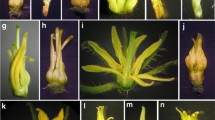Abstract.
In normal anther development in maize (Zea mays L), large hypodermal cells in anther primordia undergo a series of proscribed cell divisions to form an anther containing microsporogenous cells and three distinctive anther wall layers: the tapetum, the middle layer and the endothecium. In homozygous msca1 mutants of maize, stamen primordia are initiated normally and large hypodermal cells can be detected in developing anthers. However, the normal series of cell division and differentiation events does not occur in msca1 mutant plants. Rather, structures containing parenchymal cells and ectopic, nonfunctional vascular strands are formed. The epidermal surfaces of these structures contain stomata, which are normally absent in maize anthers. Thus, all of the cell layers of the "anther" have been transformed in mutant plants. The filaments of the mutant structures are normal, and all other flower parts are normal. The msca1 mutation does not affect female fertility, but transformed "stamen" structures remain associated with mature ovules rather than aborting as in normal ear development. The msca1 mutation is distinctive in that only one part of a single (male) reproductive organ is transformed. The resulting structure has general vegetative features, but cannot be conclusively identified as a particular vegetative organ.
Similar content being viewed by others
Explore related subjects
Discover the latest articles and news from researchers in related subjects, suggested using machine learning.Author information
Authors and Affiliations
Additional information
Electronic Publication
Rights and permissions
About this article
Cite this article
Chaubal, R., Anderson, J.R., Trimnell, M.R. et al. The transformation of anthers in the msca1 mutant of maize. Planta 216, 778–788 (2003). https://doi.org/10.1007/s00425-002-0929-8
Received:
Accepted:
Issue Date:
DOI: https://doi.org/10.1007/s00425-002-0929-8




